Home » Infrastructure
Category Archives: Infrastructure
Article share: on making more affordable neighborhoods
I’ve been commenting about how transportation cannot be isolated and the need to relate it to other factors such as housing or home location choice. The latter though is also affected by other factors as well that affect the affordability of homes near the city centers or CBDs where workplaces and schools are located. The result of course is sprawl or the encouragement of sprawl. Private companies take advantage of this or contribute to this ‘encouragement’ by developing land farther away from the center. Thus, for Metro Manila’s case, many people reside in the peripheral provinces of Bulacan, Rizal, Laguna and Cavite. There are even those who choose to reside in Pampanga, Bataan and Batangas.
Kayatekin, C.S. and Sanmiguel, L.U. (April 16, 2024) ” ‘Urban form’ and the housing crisis: can streets and buildings make a neighborhood more affordable?” The Conversation, https://theconversation.com/urban-form-and-the-housing-crisis-can-streets-and-buildings-make-a-neighbourhood-more-affordable-224108 [Last accessed: 4/23/2024]
Quoting from the article:
“Our main finding was that the bottom-up districts we looked at had, overall, more small-scale apartments. The reason is simple: they had more small-scale buildings, built on small-scale plots. Once divided into apartments, this produces small apartments – homes in the bottom-up areas were 10% to 23.1% smaller than their top-down counterparts. This also made their real estate markets for small homes more competitive, and therefore more affordable.
However, our study showed there is nothing inherently magical about bottom-up areas. Their more intricate housing stock has little to do with the layout of streets and blocks, and a lot to do with how that land is built upon.
Plot size appears to be the deciding factor: the districts with greater numbers of small buildings built on small plots supported a denser and more affordable housing stock, regardless of whether they were top-down or bottom-up.
Older bottom-up areas seem to naturally lend themselves to having more small-scale plots. This is likely due to the incremental development of these areas, and the complex land ownership patterns that developed as a result. However, there is no reason why a top-down area cannot be designed to replicate these characteristics.”
–
More than just painted lines – good practice examples of bike lanes
I’m sharing this article on the best bike lanes in the United States:
Holbrook, A. (February 12, 2024) “The 5 Principles That Make America’s Best Bike Lanes: A Lot More Than Painted Lines,” Velo, https://velo.outsideonline.com/urban/urban-gear/five-principles-the-best-bike-lanes/ [Last accessed: 2/15/2024]
This is a follow-up on an article on the best new bike lanes or bikeways that I shared earlier. This article features an interview of the author of the previous article about what features distinguish these bike lanes over others that have been implemented. Definitely, bike lanes should be designed beyond the usually painted lines that offer little protection to cyclists.
Here are examples of bike lanes in the Philippines:
 Painted bike lanes along Ortigas Avenue Extension, Cainta, Rizal
Painted bike lanes along Ortigas Avenue Extension, Cainta, Rizal
 Protected bike lane along Katipunan Avenue (C-5), Quezon City
Protected bike lane along Katipunan Avenue (C-5), Quezon City
–
Zamboanga’s first flyover
We passed by the construction site of Zamboanga City’s first flyover at the intersection of the Pan Philippine Highway (AH 26) and Veteran’s Avenue. I recall there was a lot of pressure from DPWH for the city to approve its construction. The previous mayor didn’t want to approve the project because the perception was that it was not required and there were other options to consider before a flyover was to be constructed. However, many people including the then congressman and now mayor probably thought the flyover would be the solution to the congestion experienced at the intersection. Add to that the perception that the flyover is also somewhat a symbol of progress.
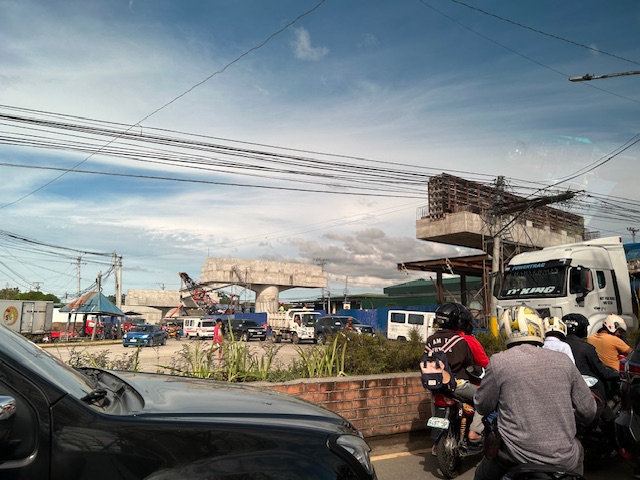
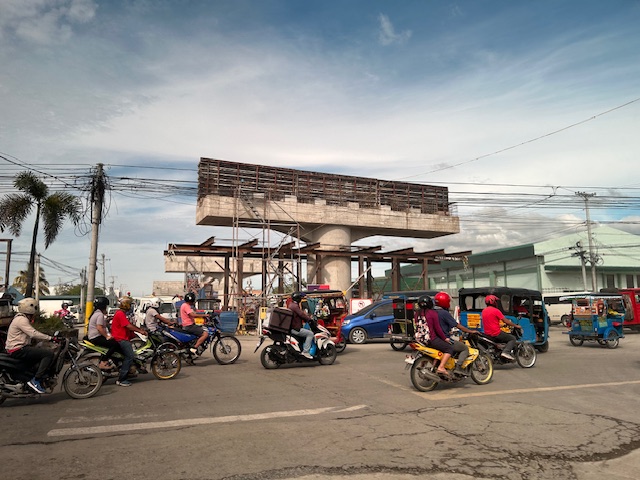
We won’t know until its completion and the ‘normalization’ of traffic in the area to determine whether the flyover has ‘solved’ traffic congestion in the area. The problem with this approach to ‘solving traffic’ is that it is usually a short-lived alleviation of a symptom of the real problem, which is transportation. Zamboanga City has deferred rationalization of public transport routed despite analysis and plans pointing to a streamlined and optimized transportation system if this was pursued. The City commissioned a Transportation and Traffic Management Plan Study in the previous administration but the plan and its recommendations have been shelved, another example of such being casualties of a change in administration of an LGU.
–
Lagusnilad now
The underpass across from the Manila City Hall is called Lagusnilad. The underpass is prone to flooding and had been neglected for a long time under several administrations spanning several Presidents, DPWH Secretaries and Manila Mayors. Kudos to the recent Mayor and DPWH officials who finally addressed the flooding problem as well as improved the pavement and lighting for Lagusnilad.
 Approach to the lowest point of the underpass from Padre Burgos Avenue, one notes the now well-lit underpass and the solar studs marking the lanes.
Approach to the lowest point of the underpass from Padre Burgos Avenue, one notes the now well-lit underpass and the solar studs marking the lanes.
 The lowest section of the underpass is prone to flooding but major rehab works to the drainage plus new pumps appear to have addressed the problem.
The lowest section of the underpass is prone to flooding but major rehab works to the drainage plus new pumps appear to have addressed the problem.
 Emerging from the underpass towards Taft Avenue
Emerging from the underpass towards Taft Avenue
I have memories of when this underpass was often flooded back in the 1990s including a time when vehicles braved the waters and got stuck after drivers discovered just how deep the waters can be. The joke then was that the underpass would be renamed ‘Langoynilad’, alluding to people and vehicles having to swim to traverse this section.
There is also a pedestrian underpass that is called Lagusnilad. This connects City Hall with Intramuros and used to be so dirty and stinky. Again, credit is due to recent officials who rehabilitated the underpass to what is now a tourist attraction but more importantly a good practice example for pedestrian facilities.
–
Quezon City’s bike lane barriers
Here’s a first look at Quezon City’s new bike lane barriers along Katipunan Avenue (C-5). I took these photos while crawling towards Ateneo Gate 3 on my way to the office.


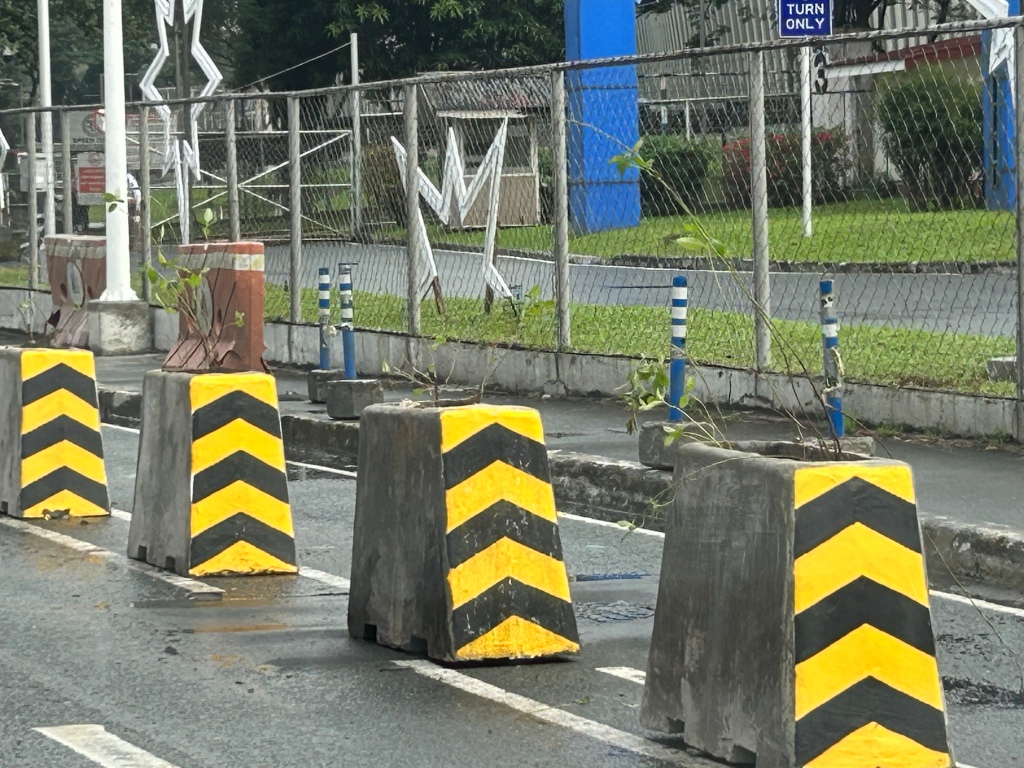

The same or similar barriers/planters have been installed along other major roads including Commonwealth Avenue. This is part of Quezon City’s commitment to building a bikeway/bike lane network and a worthy investment to encourage more people to take up cycling especially for work and school trips. The barriers serve to protect cyclists from motor vehicles thereby enhancing safety along these roads. Hopefully, other LGUs will follow suit and invest in active transport facilities.
–
Article share: Drought and the Panama Canal
Here’s a quick share of an article on how a drought is affecting operations of the Panama Canal:
Eavis, P. (November 1, 2023) “Drought Saps the Panama Canal, Disrupting Global Trade,” Wired, https://www.nytimes.com/2023/11/01/business/economy/panama-canal-drought-shipping.html?unlocked_article_code=1.7kw.9CNJ.NKhQS8RCMh9h&smid=url-share [Last accessed: 11/3/2023]
From the article:
“But a drought has left the canal without enough water, which is used to raise and lower ships, forcing officials to slash the number of vessels they allow through. That has created expensive headaches for shipping companies and raised difficult questions about water use in Panama. The passage of one ship is estimated to consume as much water as half a million Panamanians use in one day…
Without a new water source, the canal could lose significant amounts of business. Other ocean routes are, of course, longer and more expensive, but they are less likely to have unpredictable delays. One alternative is to transport goods between Asia and United States through the Suez Canal to the East Coast and Gulf Coast. Another is to ship goods from Asia to the West Coast ports — and then transport them overland by train or truck…”
I suddenly remembered the current work along the Marikina River. The government is supposed to be working towards making the river navigable for the Pasig River Ferry to extend operations there. However, the depth of the river prevents regular, reliable operations. I wonder if the current project that includes flood control, riverside roads and erosion control components also will lead to a navigable depth for the river for most if not the whole year.
–
Article share: On the benefits of sidewalk networks
Here is another quick share of an article by Todd Litman on Planetizen. The article contains a lot of information or data about why we should be investing in sidewalks or pedestrian facilities (i.e., for walking).
Litman, T. (August 6, 2023) “Completing Sidewalk Networks: Benefits and Costs,” Planetizen, https://www.planetizen.com/blogs/124999-completing-sidewalk-networks-benefits-and-costs?utm_source=newswire&utm_medium=email&utm_campaign=news-08142023&mc_cid=cd3b2e2ba5&mc_eid=9ccfe464b1 [Last accessed: 9/23/2023]
To quote from the article:
“Walking is the most basic and universal travel mode, and sidewalks are the most basic walking infrastructure, but they are often overlooked and undervalued in transportation planning. Completing and improving sidewalk networks can help achieve many economic, social and environmental goals.
Recent case studies indicate that typical North American communities spend $30 to $60 annually per capita on sidewalks, and would need to double or triple these spending levels to complete their networks. This is a large increase compared with current pedestrian spending but small compared with what governments and businesses spend on roads and parking facilities, and what motorists spend on their vehicles. Sidewalk funding increases are justified to satisfy ethical and legal requirements, and to achieve various economic, social and environmental goals. There are several possible ways to finance sidewalk improvements. These usually repay their costs thorough savings and benefits.”
–
Another look at the Mactan Cebu International Airport Terminal 1 – Part 3
This is the conclusion to the series on MCIA Terminal 1. Here I am sharing more photos of the shops and also include photos of what used to be the old terminal 1 boarding gates areas that have now been completely renovated.
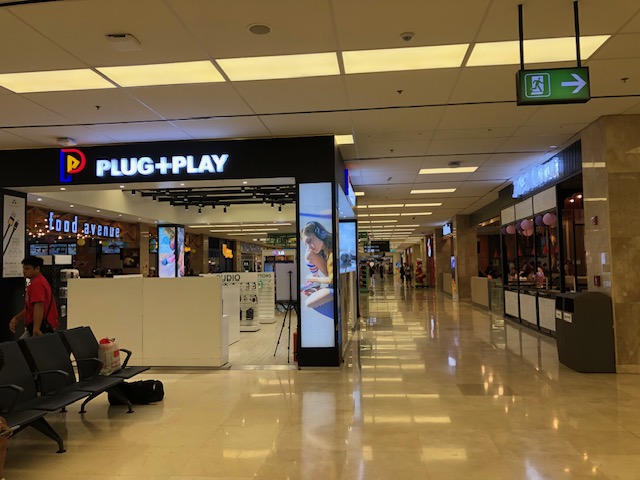 Electronics shop at the MCIA Terminal 1
Electronics shop at the MCIA Terminal 1
 There’s a sports bar at Terminal 1
There’s a sports bar at Terminal 1
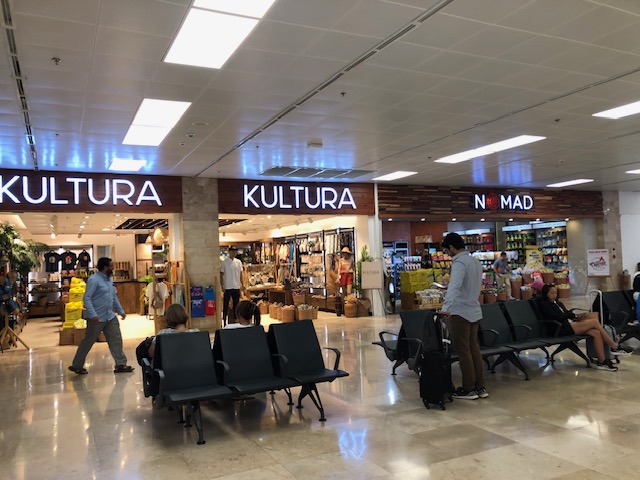 There’s a Kultura shop at the Terminal 1. Kultura is SM’s
There’s a Kultura shop at the Terminal 1. Kultura is SM’s
 Liquors and wines store at the terminal – I was not able to inquire if these can be duty free considering the people including foreign tourists who may avail of this.
Liquors and wines store at the terminal – I was not able to inquire if these can be duty free considering the people including foreign tourists who may avail of this.
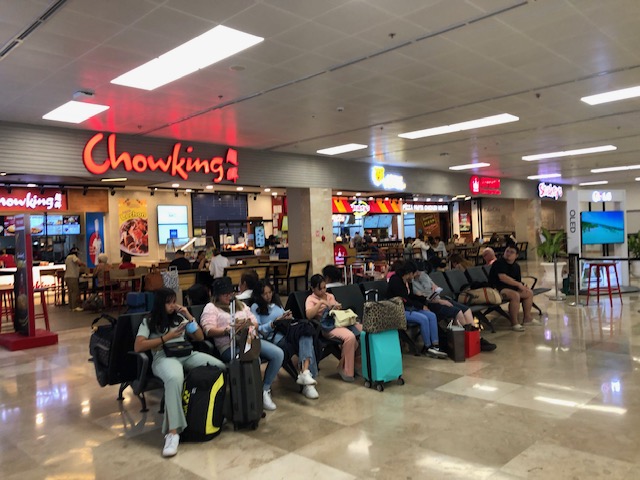 Passengers seated along a row of restaurants at the old Terminal 1 domestic wing. This area used to be crowded with so many chairs that they tried to fit in the area.
Passengers seated along a row of restaurants at the old Terminal 1 domestic wing. This area used to be crowded with so many chairs that they tried to fit in the area.
 Familiar brands Dunkin’ Donuts and Bo’s Coffee are there. There are also vending machines for drinks for the more straightforward purchases.
Familiar brands Dunkin’ Donuts and Bo’s Coffee are there. There are also vending machines for drinks for the more straightforward purchases.
 The pre-departure area of the old T1 domestic wing now appears more spacious.
The pre-departure area of the old T1 domestic wing now appears more spacious.
 Corridor to the old T1 domestic wing now full of shops
Corridor to the old T1 domestic wing now full of shops
More on airports soon!
–
Another look at the refurbished Mactan International Airport Terminal 1 – Part 2
In this part of the series, I am sharing photos of the various shops and eating options at the MCIA Terminal 1.
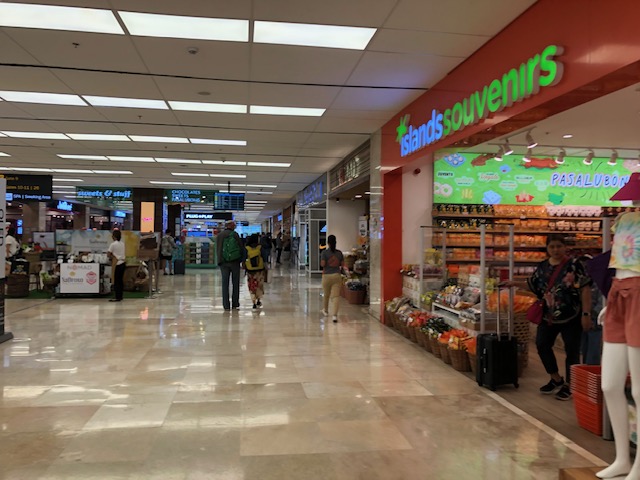 A familiar store at airports is Islands Souvenirs. I think I have an Island Souvenir shirt for most of the cities I’ve traveled to in the country. It is a go-to store for souvenir items, especially shirts.
A familiar store at airports is Islands Souvenirs. I think I have an Island Souvenir shirt for most of the cities I’ve traveled to in the country. It is a go-to store for souvenir items, especially shirts.
 There are many kiosks along the corridors leading to the gates. Some sell souvenir items. Others gadgets and accessories. There are even a couple marketing real estate in Cebu.
There are many kiosks along the corridors leading to the gates. Some sell souvenir items. Others gadgets and accessories. There are even a couple marketing real estate in Cebu.
 A look inside the Islands Souvenirs shop shows many items to choose from including shirts, bags, caps, mugs and magnets.
A look inside the Islands Souvenirs shop shows many items to choose from including shirts, bags, caps, mugs and magnets.
 I think this store was what used to be a Cocoa Tree store at the terminal. It still sells pretty much the same products (mainly chocolates).
I think this store was what used to be a Cocoa Tree store at the terminal. It still sells pretty much the same products (mainly chocolates).
 There is a nice food court at Terminal 1. You have many choices for eating or drinking. And I noticed the prices are also not as expensive as perceived of Philippine airport food and drinks.
There is a nice food court at Terminal 1. You have many choices for eating or drinking. And I noticed the prices are also not as expensive as perceived of Philippine airport food and drinks.
 The food court is spacious and people can just stay here for refreshments while waiting for their flights to board.
The food court is spacious and people can just stay here for refreshments while waiting for their flights to board.
 Aside from Filipino food, there’s Italian and Japanese themed stalls at the food court.
Aside from Filipino food, there’s Italian and Japanese themed stalls at the food court.
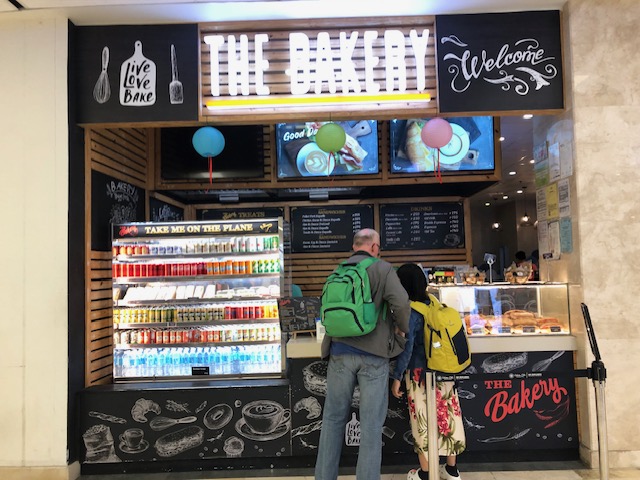 I think my favorite there is The Bakery, which offers sandwiches, pastries and various breads. They also have pasta for those wanting a heavier meal before their flights.
I think my favorite there is The Bakery, which offers sandwiches, pastries and various breads. They also have pasta for those wanting a heavier meal before their flights.
 There’s a WHSmith store at Terminal 1. The photo also shows massage chairs and a local souvenir shop, District Fiesta.
There’s a WHSmith store at Terminal 1. The photo also shows massage chairs and a local souvenir shop, District Fiesta.
 District Fiesta offers local products including handicrafts like bags, purses, decors, etc.
District Fiesta offers local products including handicrafts like bags, purses, decors, etc.
More in Part 3, coming soon!
–
Another look at the refurbished Mactan Cebu International Airport Terminal 1 – Part 1
We were recently in Cebu City and I just had to take some new photos; this time to feature Terminal 1 of Mactan Cebu International Airport. Here are some photos taken at the departure area.
 Entrance towards the check-in counters. There is no security machine here and but there is a routine check of travel documents of passengers. There are weighing scales for luggage so passengers can check if they are over their limits and still have an opportunity (and the space) to reconfigure.
Entrance towards the check-in counters. There is no security machine here and but there is a routine check of travel documents of passengers. There are weighing scales for luggage so passengers can check if they are over their limits and still have an opportunity (and the space) to reconfigure.
 PAL’s check-in counters at MCIA Terminal 1
PAL’s check-in counters at MCIA Terminal 1
 PAL also now has online check-in machines at the airport. Previously, only Cebu Pacific had these machines. There is only one though unlike Ceb Pac’s multiple machines.
PAL also now has online check-in machines at the airport. Previously, only Cebu Pacific had these machines. There is only one though unlike Ceb Pac’s multiple machines.
 Check-in counters for Air Asia Philippines
Check-in counters for Air Asia Philippines
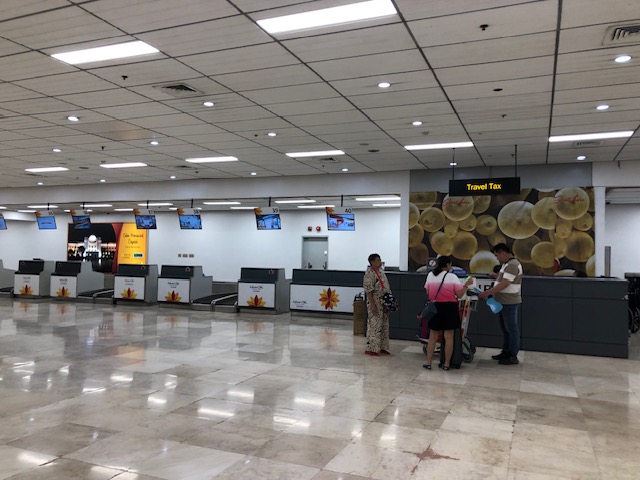 Travel tax counter at the terminal
Travel tax counter at the terminal
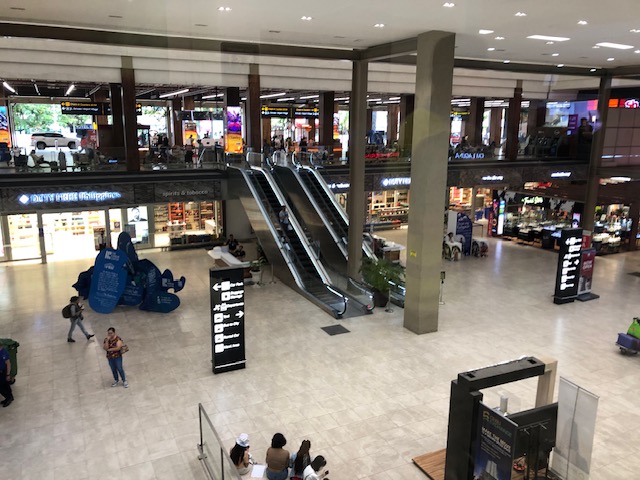 A view of the terminal lobby from the corridor leading to our gate at the other end of Terminal 1.
A view of the terminal lobby from the corridor leading to our gate at the other end of Terminal 1.
 Final security check before the pre-departure areas. MCIA now uses modern scanners for screening both bags and passengers. Shoes and belts are among the items they require you to remove from yourself. They also ask you to remove notebook computers to place them on your tray that goes through the machines. You may not remove your watch from your wrist.
Final security check before the pre-departure areas. MCIA now uses modern scanners for screening both bags and passengers. Shoes and belts are among the items they require you to remove from yourself. They also ask you to remove notebook computers to place them on your tray that goes through the machines. You may not remove your watch from your wrist.
More photos in Part 2 coming soon!
–
